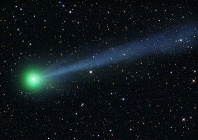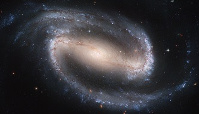Asteroids
Meteors are just bits of dustor rocks from space that get sucked into the Earth’s gravitational pull when they come to close to it. As they enter our atmosphere and plummet towards the ground, they burn up, usually about 60 miles before they get close enough to hit you in the head. When the meteors burn up, we on the ground can sometimes see the brief flash of light. This is what people call “shooting stars.” Usually, the “space dust” that make meteors comes from the tails of passing comets. Every once in a while, a meteor will be big enough to weather its fiery descent and land on Earth, where it earns the title “meteorite.”
Black holes
A black hole is a place in space where gravity pulls so much that even light can not get out. The gravity is so strong because matter has been squeezed into a tiny space. This can happen when a star is dying.
Because no light can get out, people can’t see black holes. They are invisible. Space telescopes with special tools can help find black holes. The special tools can see how stars that are very close to black holes act differently than other stars.
Comets
Comets are often referred to as “dirty snowballs.” They are left over from the formation of stars and planets billions of years ago. Before zipping around the Sun with their characteristic big tails, comets that we see in our solar system start out as big chunks of rock and ice just floating around in something called the Oort Cloud. When the gravity from a large passing body, like a star, becomes strong enough, some large chunks of ice get pulled away from the cloud and head toward the Sun.
Galaxies
A galaxy is a massive, gravitationally bound system consisting of stars, stellar remnants, an interstellar medium of gas and dust, and dark matter, an important but poorly understood component. The word galaxy is derived from the Greek galaxias (γαλαξίας), literally “milky”, a reference to the Milky Way. Examples of galaxies range from dwarfs with as few as ten million (107) stars to giants with one hundred trillion (1014) stars each orbiting their galaxy’s own center of mass.
Moons
A moon is defined to be a celestial body that makes an orbit around a planet, including the eight major planets, dwarf planets, and minor planets. A moon may also be referred to as a natural satellite, although to differentiate it from other astronomical bodies orbiting another body, e.g. a planet orbiting a star, the term moon is used exclusively to make a reference to a planet’s natural satellite.
Planets
Technically, there was never a scientific definition of the term Planet before 2006. When the Greeks observed the sky thousands of years ago, they discovered objects that acted differently than stars. These points of light seemed to wander around the sky throughout the year. We get the term “planet” from the Greek word “Planetes” – meaning wanderer.
Stardust
 Stardust grains (also called presolar grains
by meteoriticists) are contained within meteorites, from which they are
extracted in terrestrial laboratories. The meteorites have stored those
stardust grains ever since the meteorites first assembled within the
planetary accretion disk more than four billion years ago.
Stardust grains (also called presolar grains
by meteoriticists) are contained within meteorites, from which they are
extracted in terrestrial laboratories. The meteorites have stored those
stardust grains ever since the meteorites first assembled within the
planetary accretion disk more than four billion years ago.
So-called carbonaceous chondrites are especially fertile reservoirs of stardust.
Each stardust grain existed before the Earth was formed. Stardust is a scientific term referring to refractory dust grains that condensed from cooling ejected gases from individual presolar stars and mixed into the cloud from which the Solar System condensed.
Stars
A star is a massive, luminous sphere of plasma held together by its own gravity. The nearest star to Earth is the Sun, which is the source of most of the planet’s energy. Some other stars are visible from Earth during the night, appearing as a multitude of fixed luminous points due to their immense distance. Historically, the most prominent stars were grouped into constellations and asterisms, and the brightest stars gained proper names.








